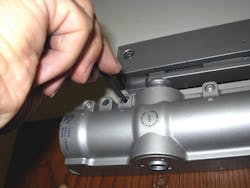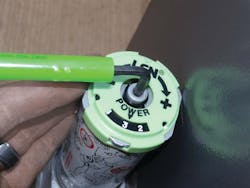This article will provide some guidelines to identifying service issues that occur in door closers and how to resolve them.
But before addressing the troubleshooting steps, we should review some important code-compliance information about door closers. After all, if we tell you that you have to adjust the door closer, it would be meaningful only if we give you guidelines as to what the adjustment should be.
Door closers have been around for more than 100 years in different configurations, and the evolution of engineering, design and manufacturing technologies has resulted in a reliable group of products. The extended warranties offered by many manufacturers are proof of their confidence in the products.
Because door closers are used for applications where life safety is involved, they’re tested stringently and graded so they can be installed properly and used appropriately. Locksmiths must exercise their best judgment when they select and install door hardware as critical to safe operation as the door closer is.
Beyond the life-safety issues associated with any door, door closers can create potentially dangerous slip-and-fall conditions to pedestrians if they leak hydraulic fluid. Installers could be injured if the body of the closer were punctured inadvertently by a drill, such as when mounting a maglock on a header that has a concealed closer. A powerful spring can whip the closer arm violently if the pressure inside the closer is released suddenly.
Selling and upgrading door closers is a lucrative activity for locksmiths, and with overhead surface-mount types, installing them can be performed by one mechanic rather than a door crew. It’s wise to keep closers on your service vehicle so you can be prepared to come to the rescue (and make the sale.)
Door Closers 101
Door closers aid in air handling and environmental control, fire and smoke mitigation and are an integral component in securing an opening and a building.
Door closers most often are used on doors in commercial buildings. They’re required by code on all fire doors and necessary on doors that have electronic access control, so the door will self-close and latch.
Doors used for other purposes, such as non-emergency perimeter doors, interior doors in hallways and doors to rooms and areas also are good candidates for a door closer.
Door closers come in several types:
Floor threshold closers: Provided by the door manufacturer as part of the door system.
Floor closers and concealed header closers often are used with pivots rather than hinges, and might deliver biswing functionality.
Overhead (Surface-mounted) closers: These comprise the majority of the closers locksmiths will encounter. They can be installed on existing doors and be replaced or upgraded when necessary without removing the door from the opening to service or replace it.
There are five types of surface-mount installations:
- Regular Arm: The regular arm, or standard arm, closer is a pull-side application. The door closer is mounted on the door. The arm, when closed, projects out perpendicular from the door. This is the most power-efficient option.
- Top Jamb: As the name suggests, the closer is mounted on the top jamb (not on the door), typically because the top jamb of the door is too narrow to accommodate the closer body. Top jamb door closers, like regular arm closers, have arms that project out perpendicular from the door.
- Parallel Arm: Parallel-arm door closers are used in commercial properties and schools. The arm rests parallel to the surface of the door, which reduces the risk of vandalism or damage to a protruding (and inviting) arm. This type of installation is obtrusive.
- Track Arm: These track-mounted closers have a roller that runs along a metal channel track as the door opens and closes. The track arm can be mounted on the push or pull side of an opening. In both cases, the closer body is mounted to the door. For push side mounting, the track is attached to the soffit of the frame head. When installed on the pull side, the track is mounted to the face of the frame head.
- Corner bracket: This uncommon surface-mounted closer option is used when the door has an angled or arched top rail. A bracket is attached on the pull side of the opening in the top corner of the frame and the closer body is installed onto the bracket while the arm is attached to the face of the door.
Door closers aren’t created equal, because all openings aren’t the same. Federal, state and even local building codes can have an effect on determining the door closer required.
Keep Control
The Americans with Disabilities Act (ADA) states that interior doors should require no more than 5 pounds of force to operate but doesn’t specify the force required for exterior doors.
The typical maximum opening force for exterior doors is 8.5–10 pounds. Any door so heavy and difficult to open that it prevents entrance by people who have disabilities might deny them access, which the ADA was enacted to prevent.
When it comes to door closers, you should be a “control freak. A door always should be under control when it’s being opened, while it’s closing and when it’s closed.
When the door is opened, it’s under the control of the person who opens it. The closer’s backcheck setting controls how many pounds of force are necessary to open the door and how the door behaves when it’s opened to the angle desired. The closer’s springs and hydraulics control those parameters. The door closer might have an adjustable tension spring, which can be adjusted to accommodate the weight of the door.
After the door is opened and released by the pedestrian, if the door closer has a delayed-action feature, the door will remain open momentarily or begin to close.
High-end door closers have adjustments for the following:
- Backcheck position
- Backcheck cushion
- Closing swing speed
- Latch engage
- Latch speed
- Closing power control
Troubleshooting the Closer
Begin by inspecting for obvious damage to the door, frame and door hardware accessories. Is there any liquid on the door or floor or threshold? We’re looking for hydraulic fluid from a leaking door closer, but other fluids, such as from a leaking pipe or roof, aren’t good either. A leaking door closer must be replaced or factory serviced. Check the hydraulics. Hydraulic valves might have to be adjusted properly.
Check to make sure the door closer is attached firmly to the door. Is all the mounting hardware present? Is the door warped from stress exerted on the closer or arm? Was through-bolting used? Is the arm bent or are parts missing? You might have to confirm that the closer and arm were mounted in the proper location.
Open the door to the full open position and let it close. Did the door bind when it was opened past the frame? Did the door resist being opened and was the resistance bumpy and uneven, or was it smooth and intuitively normal?
A damaged door, frame or hinges can be the issue rather than the door closer. When you opened the door, could you feel the backcheck engage and cushion the opening of the door when it reached the limit of its arc?
When the door closed, did it swing at the appropriate speed? You can count to yourself or use the timer in your phone to see whether the speed is in spec.
When the door reached near the end of its closing arc, did it close and latch? Not latching can be because of a poorly adjusted latch speed or latch engage position, a misalignment between the latch and the strike or a door edge that interferes with the frame. It could be a warped frame or loose or damaged hinges. If this is a new installation, perhaps the door lock, latch or strike wasn’t specified, aligned or set up properly.
If the door is inswinging, did it slam when it closed? If the door is outswinging, did the door stall right before it reached the latch position? Stack pressure caused by heating or cooling systems that cause unequal pressure on the opposite side of the door might be a contributing factor.
Verify that the tension spring was properly preloaded when the closer arm was installed. Try to adjust the latch setting or adjust the closer spring tension. The issue might be more involved than a closer setting or malfunction.
Did the door rub on the threshold? Is there any dirt or debris trapped between the door and frame on the hinge edge?
If valve adjustments don’t seem to make any noticeable changes, it might be the closer. You might have the wrong size door closer for your door. If you endeavor to adjust the door, be sure to use a door pressure gauge.
Tim O’Leary is an experienced security consultant and a regular contributor to Locksmith Ledger.
Door Closer Checklist
- Identify the position of the closer and the shoe.
- Determine whether the arm was preloaded properly.
- Use an ADA Accessibility Force Gauge when adjusting the door closer.
- Contact tech support or the manufacturer’s online resources. They’re thorough and typically helpful.
About the Author
Tim O'Leary
Tim O'Leary is a security consultant, trainer and technician who has also been writing articles on all areas of locksmithing & physical security for many years.

